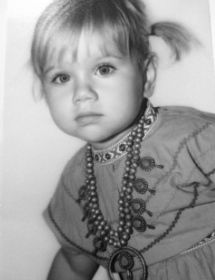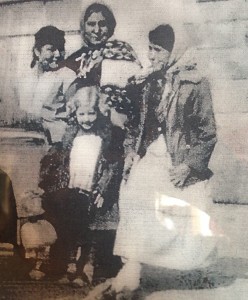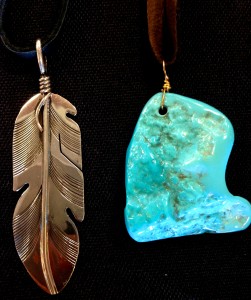Local jewelry designer Pam Evans had a childhood far from ordinary. Raised on the Navajo Nation, she was surrounded by rich tribal culture, which continues to inspire her work.
Evans founded Shonto Canyon Jewelry 20 years ago to honor the passion that began in her childhood and to keep her connected to the Navajo Nation. The jewelry company sells pieces from their website and at local resorts, but Evans travels around Arizona, Colorado and Utah with trunk shows of the jewelry collections.
“It was on the reservation that I fell in love with jewelry and art, the colors of the Navajo,” Evans said.
She said she appreciates the Navajo way of life and that she wouldn’t be who she is today had she grown up in a suburb, and furthers her connection to where she was raised by donating the proceeds of the jewelry sales to the Women and Children’s Shelter for Domestic Violence in Shonto Canyon on the Navajo Nation Territory.
She spent her childhood at Two Grey Hills trading post, which is located an hour southwest of Mesa Verde, between Shiprock and Gallup. Evans describes her early life as isolated and simple. Because there were no playgrounds, television sets or “modern” entertainment, Evans said she found enjoyment in painting, in colored rocks, and in rugs and handmade dolls.

Her journey and connection to the Navajo culture began back in the late 1800s when her grandfather, Stokie Carson, pitched a tent on the territory at Two Grey Hills, New Mexico. He then established a trading post and became the first white man on the reservation to trade with Navajo people.
He did not speak the Navajo language when he first opened the trading post but quickly learned what was necessary to do business and better understand what was coming and going through the post.
According to Evans, Carson traded rugs, wool, piñon nuts and lambs for food and dried goods, living off the goods he was trading while also making a profit. His success led to his purchase of other posts on the reservation near Page and in Shonto Canyon.
When Carson became too old to manage the posts himself in the 1940s, his four daughters acquired them. One of his daughters, Marie Carson, went on to marry Willard Leighton and eventually gave birth to Pam (Evans) Leighton.

Evans said she never learned to speak the Navajo language, although both her parents did. She felt connected to the post visitors through their art, culture and friendly dispositions.
“I remember when I was a little girl, I watched my grandpa buy this rug from a young Indian girl and it wasn’t that pretty of a rug, but he told her how much he loved it and she was so pleased,” Evans said. “After she left, he told me he would probably never trade the rug but he didn’t care, because he loved giving people pride in what they do,” Evans said.
Evans said Shonto Canyon Jewelry was her way of expressing pride in where she came from – and that’s what she wants people to take away from the pieces she designs.
The jewelry is handmade by people of the Navajo Indian Jewelry Manufacturers and designed only by Evans. Semi-precious stones, turquoise, sterling silver, gold and copper make up many of the materials that are used to piece together necklaces, rings and earrings.
According to Evans, growing up in the only white family on the reservation taught her, early on, the importance of equality. Evans said she never understood prejudice because it never existed in her life. In the Navajo world, all who walk the earth are equal.
Each piece is one of a kind and made from materials extracted from the earth in Arizona and New Mexico. Evans admits that times are changing and it is harder to sell handmade items because of competition from corporate jewelry industries. Evans fears that Shonto Canyon Jewelry may have to move fully online or stay at Two Grey Hills, but she wants people to realize how special the jewelry is and the pride the artisans take in making the pieces.

She supports the shelter because domestic violence is a prevalent problem for native nations, where many families are stricken by poverty.
“Some dirt roads you drive down, and there are these huge signs that say it’s not OK to be abused or to abuse others. It’s so terrible.” Evans said.
Domestic violence has reached an all-time high on the Navajo Nation. One of every three Navajo citizens are at one point in their lives a victim of domestic violence, according to the Health, Education and Human Services Committee of The Navajo Nation Council.
The Navajo Nation is the largest in the U.S., spanning 30,000 square miles with a population of more than 300,000 people.
The Navajo recently revised domestic violence laws, making it easier for those who have been abused to seek help and better protection.
Although Evans is saddened by the violence, she hopes the donations to the shelter will benefit some of the Navajo people.
“Shonto Canyon means sunlit water, and that’s what I want for the women and kids at this shelter,” Evans said. “Some light.”


